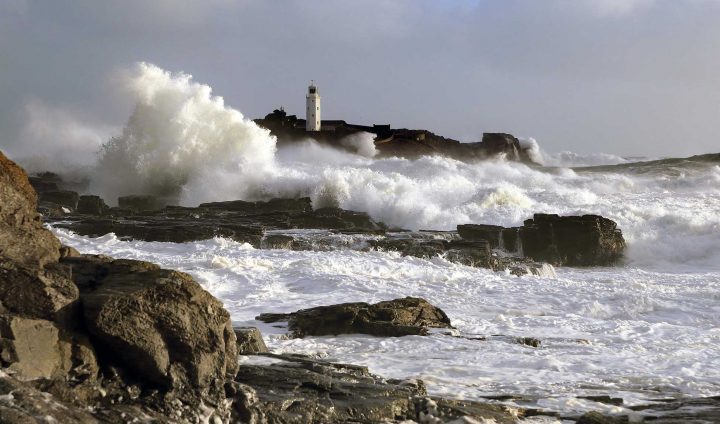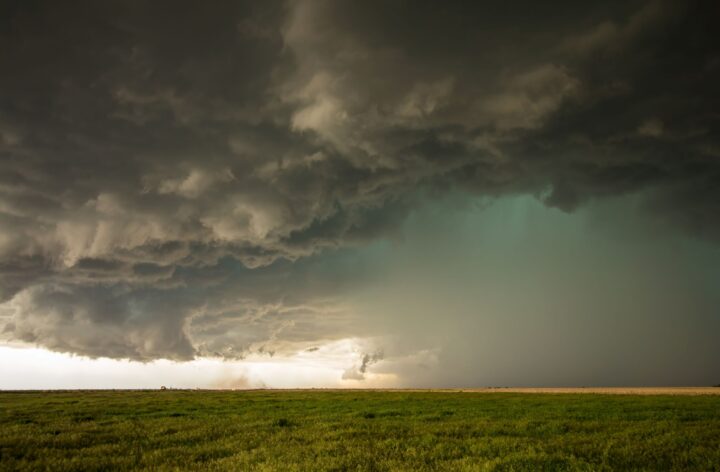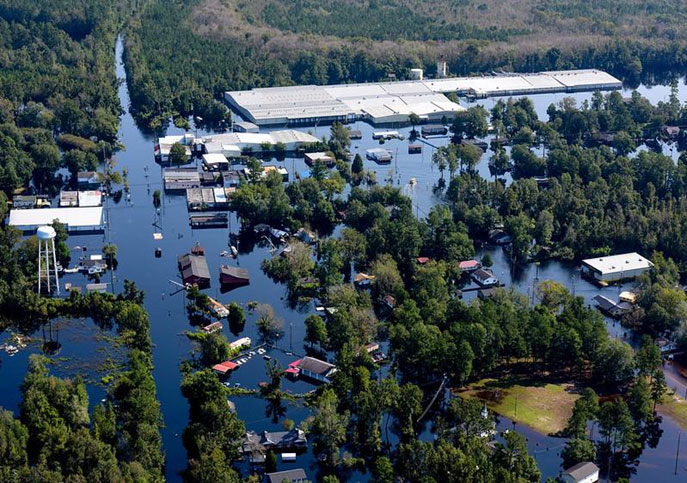Research Highlight
Poleward intensification of midlatitude extreme winds under warmer climate
 April 29, 2024 – Given the significant risks posed by near-surface extreme wind speeds associated with midlatitude cyclones to lives, livelihoods, and infrastructure, it is imperative to understand their physical changes, including magnitudes and patterns, under human-induced global climate change. This study used GFDL’s high-resolution (50 km grid-spacing) atmospheric climate model, AM4, to investigate the global impact of midlatitude cyclones on extreme wind speed events, in both hemispheres, under a warmer climate.
April 29, 2024 – Given the significant risks posed by near-surface extreme wind speeds associated with midlatitude cyclones to lives, livelihoods, and infrastructure, it is imperative to understand their physical changes, including magnitudes and patterns, under human-induced global climate change. This study used GFDL’s high-resolution (50 km grid-spacing) atmospheric climate model, AM4, to investigate the global impact of midlatitude cyclones on extreme wind speed events, in both hemispheres, under a warmer climate.
News
Understanding Earth through GFDL’s Advanced Global Models
 April 25, 2024 – In celebration of Earth Month, GFDL shares how the lab is investing to meet weather and climate goals through some of its advanced global models: CM4, SPEAR, ESM4, and SHiELD. These realistic models play an important role in enhancing our comprehension of the Earth system, each providing unique insights into the science underpinning our understanding and enabling predictions and projections.
April 25, 2024 – In celebration of Earth Month, GFDL shares how the lab is investing to meet weather and climate goals through some of its advanced global models: CM4, SPEAR, ESM4, and SHiELD. These realistic models play an important role in enhancing our comprehension of the Earth system, each providing unique insights into the science underpinning our understanding and enabling predictions and projections.
Research Highlight
Kilometer-scale global warming simulations and active sensors reveal changes in tropical deep convection
 March 28, 2024 – Under global warming, changes in the location and structure of the deep convection in the tropics have profound consequences for tropical climate. The tropics are characterized by the ubiquitous presence of high ice clouds formed by detrainment from precipitating deep convection. The bulk of these clouds are so-called anvil clouds in extensive formations that shield the convective centers.
March 28, 2024 – Under global warming, changes in the location and structure of the deep convection in the tropics have profound consequences for tropical climate. The tropics are characterized by the ubiquitous presence of high ice clouds formed by detrainment from precipitating deep convection. The bulk of these clouds are so-called anvil clouds in extensive formations that shield the convective centers.
News
Celebrating Women’s History Month with Mingjing Tong
 March 25, 2024 – GFDL celebrates Women’s History Month by recognizing the contributions of Mingjing Tong, a meteorologist, whose work focuses on improving hurricane and severe weather forecasting. Dr. Tong, a member of GFDL’s Weather and Climate Dynamics Division, previously worked as a hurricane specialist for NOAA’s National Weather Service.
March 25, 2024 – GFDL celebrates Women’s History Month by recognizing the contributions of Mingjing Tong, a meteorologist, whose work focuses on improving hurricane and severe weather forecasting. Dr. Tong, a member of GFDL’s Weather and Climate Dynamics Division, previously worked as a hurricane specialist for NOAA’s National Weather Service.
Research Highlight
Atmospheric rivers over eastern US affected by Pacific/North America pattern
 March 12, 2024 – There is a growing awareness that atmospheric river (AR) activities are responsible for a wide range of environmental and socioeconomic impacts on the West coast of the U.S. The related heavy rainfall, snowfall, and associated floods, especially during winter, have been a focus of many previous studies.
March 12, 2024 – There is a growing awareness that atmospheric river (AR) activities are responsible for a wide range of environmental and socioeconomic impacts on the West coast of the U.S. The related heavy rainfall, snowfall, and associated floods, especially during winter, have been a focus of many previous studies.
Research Highlight
Impacts of the North Atlantic biases on the upper troposphere/lower stratosphere over the extratropical North Pacific
 February 15, 2024 – The interplay between the ocean and atmosphere plays a crucial role in shaping weather patterns and temperatures around the world. Yet, the winter upper troposphere/lower stratosphere (UTLS) temperature/vertical motion response over the extratropical North Pacific induced by North Atlantic changes is not well understood. Using GFDL’s high-resolution climate model CM2.5, the authors corrected the North Atlantic Ocean circulation biases to unravel the wintertime atmospheric impacts.
February 15, 2024 – The interplay between the ocean and atmosphere plays a crucial role in shaping weather patterns and temperatures around the world. Yet, the winter upper troposphere/lower stratosphere (UTLS) temperature/vertical motion response over the extratropical North Pacific induced by North Atlantic changes is not well understood. Using GFDL’s high-resolution climate model CM2.5, the authors corrected the North Atlantic Ocean circulation biases to unravel the wintertime atmospheric impacts.
Research Highlight
Ocean biogeochemical fingerprints of fast-sinking tunicate and fish detritus
 February 8, 2024 – Marine ecosystems play a critical role in the global carbon cycle through the food web regulation of air-sea carbon fluxes and the transfer of particulate matter from the upper oceans to depth. Recent evidence has suggested that the detritus from fishes and gelatinous zooplankton, specifically the pelagic tunicates such as salps and pyrosomes, may have a disproportionate impact on the ocean’s biological pump due to them sinking approximately ten times faster than bulk detritus.
February 8, 2024 – Marine ecosystems play a critical role in the global carbon cycle through the food web regulation of air-sea carbon fluxes and the transfer of particulate matter from the upper oceans to depth. Recent evidence has suggested that the detritus from fishes and gelatinous zooplankton, specifically the pelagic tunicates such as salps and pyrosomes, may have a disproportionate impact on the ocean’s biological pump due to them sinking approximately ten times faster than bulk detritus.
News
Detection of AMOC changes and their potential impact on sea level and storm surges over the U.S. East Coast
 February 6, 2024 – Liping Zhang and Hiroyuki Murakami, scientists at GFDL, have been awarded funding for a new climate projections project that will spotlight the critical issue of extreme sea level events along the U.S. East Coast, emphasizing their societal impact. These events, often fueled by storm surges during extreme weather occurrences, substantially threaten lives and infrastructure in coastal regions.
February 6, 2024 – Liping Zhang and Hiroyuki Murakami, scientists at GFDL, have been awarded funding for a new climate projections project that will spotlight the critical issue of extreme sea level events along the U.S. East Coast, emphasizing their societal impact. These events, often fueled by storm surges during extreme weather occurrences, substantially threaten lives and infrastructure in coastal regions.


